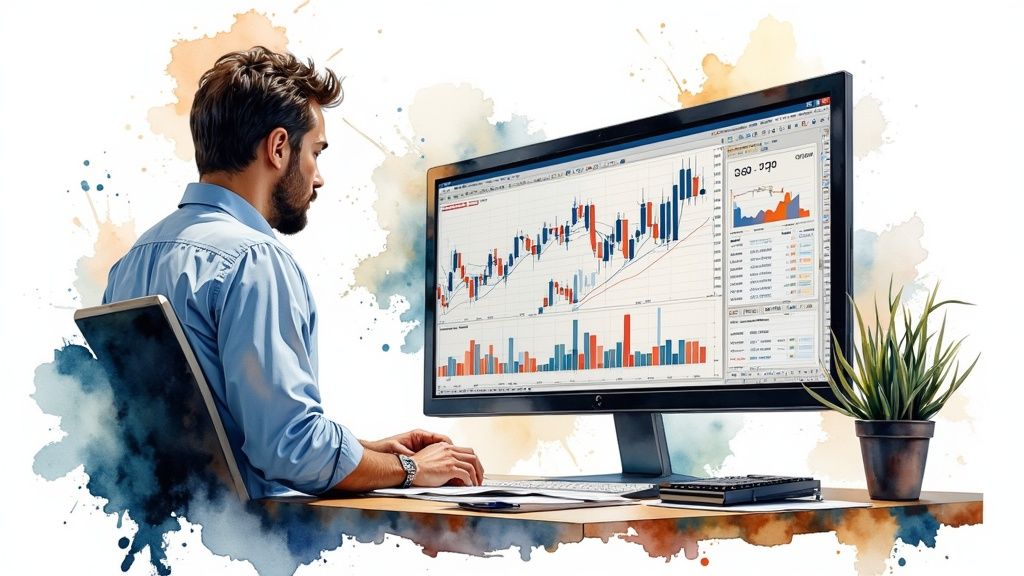



At its core, risk management in trading is about protecting capital while maximizing profit potential. Rather than being just a set of rules to follow, it provides the essential framework that allows traders to make sound decisions and survive market volatility. When properly implemented, risk management principles help preserve trading capital during inevitable market downturns.
While many new traders focus solely on potential profits, the reality is that proper risk management often determines long-term success. Studies show that approximately 80% of traders struggle with risk management, frequently leading to significant account losses. In contrast, the most successful traders make risk management their top priority before considering profits. This disciplined approach to preserving capital enables them to stay in the game during challenging periods and take advantage of opportunities when market conditions improve.
Successful risk management relies on several fundamental principles that can be adapted based on individual trading styles and market conditions:
Assessing Risk Tolerance: Knowing your personal risk comfort level is essential for determining appropriate position sizes. Conservative traders may risk only 1% of capital per trade, while more aggressive traders might risk 2%. This percentage-based approach helps keep potential losses manageable, especially for smaller accounts under $100,000.
Market Psychology: Understanding how emotions affect trading decisions is critical. Fear often causes premature exits from winning trades, while greed can lead to holding losing positions too long. Successful traders develop systems to manage these emotions and base decisions on analysis rather than impulse.
Position Sizing: Calculating the right position size for each trade directly impacts risk exposure. This calculation considers the potential loss relative to total account size and aligns with predetermined risk parameters like the 1% rule to protect trading capital.
Stop-Loss and Take-Profit Orders: Using these automated orders helps maintain discipline and manage risk consistently. Stop-losses limit downside by exiting trades at predetermined price levels, while take-profit orders lock in gains at target prices. Together, they remove emotional decision-making from trade management.
Beyond specific techniques, effective risk management requires developing a mindset focused on capital preservation. This includes accepting that losses are a normal part of trading while consistently reviewing and adjusting strategies as market conditions change. Regular evaluation ensures risk management remains effective and allows traders to adapt to new market challenges. By following these principles with discipline, traders can better protect their capital while pursuing consistent profitability in the financial markets.

The one-percent rule stands as a fundamental principle for protecting trading capital. At its core, this rule states that traders should risk no more than 1% of their total capital on any single trade. For a $10,000 account, this means limiting potential losses to $100 per trade. When placing a trade with a stop-loss that could result in a $100 loss, traders must carefully size their position to stay within this limit. This simple yet powerful approach helps prevent devastating losses, especially for those managing smaller accounts.
The one-percent rule requires thoughtful adaptation based on individual trading approaches. Day traders who execute multiple trades daily often choose to be more conservative, limiting risk to 0.5% per trade to account for the higher frequency of trades. Market conditions also influence how traders apply this rule - those trading volatile assets like cryptocurrencies typically use smaller position sizes compared to those trading stable blue-chip stocks. This flexible approach ensures the rule remains effective across different market environments.
Proper position sizing forms the backbone of implementing the one-percent rule. The calculation follows this formula:
For example, with a $25,000 account and a stop-loss 50 points away from entry at $1 per point, the position size would be (250 / 50) * 1 = 5 shares. This ensures losses remain capped at 1% even if the trade hits the stop-loss. The key is setting stop-losses based on solid analysis rather than arbitrary levels.
When trading multiple positions, traders must consider their total risk exposure. The combined risk across all open trades should stay within the chosen percentage of capital. This often means reducing individual position sizes when holding concurrent trades to maintain appropriate risk levels.
As account size grows, traders may consider carefully increasing position sizes. However, this must be done systematically - increases should align with account growth rather than recent wins. Some traders use a tiered approach, gradually moving from 1% to 1.5% risk as their capital expands significantly. Success comes from consistently applying these principles while adjusting to changing market conditions.

The one-percent rule sets a good foundation, but experienced traders often need more precise tools to manage risk effectively. Value-at-Risk (VaR) models offer a statistical approach that combines different risk factors into a single, measurable number. This helps traders clearly understand the maximum potential loss they might face on their positions within a specific time period and confidence level.
VaR expresses risk in concrete terms - either as a dollar amount or portfolio percentage. Take a daily VaR of $1,000 at 95% confidence: this means there's only a 5% chance of losing more than $1,000 in one trading day. For most traders, this clear benchmark makes it much easier to assess risk and make smart decisions about position sizing. The flexibility to adjust confidence levels also lets traders fine-tune their risk assessment based on market conditions and personal risk tolerance.
Traders can choose from several VaR calculation methods depending on their needs:
Historical Simulation: This straightforward approach uses past market data to model potential future losses. While easy to implement, it assumes historical patterns will continue.
Variance-Covariance Method: By assuming normal distribution of returns, this method uses standard deviation and correlation for VaR calculations. It works well in stable markets but can miss extreme events.
Monte Carlo Simulation: This method creates thousands of random market scenarios based on statistical models. Though computationally heavy, it excels at capturing complex market behaviors and unusual distributions.
The choice of VaR method and interpretation requires careful consideration. Research by the Federal Reserve Bank of New York shows that shorter observation periods create more volatile VaR measures, while longer periods offer more stability. This means traders must match their observation period to their strategy and current market environment. Historical methods also tend to overstate risk at high confidence levels, so understanding each approach's limitations is essential.
VaR models are powerful but have limits - they don't predict worst-case scenarios, only statistical probabilities within normal ranges. Smart traders combine VaR with other tools like stop-losses and position sizing rules. For example, VaR analysis can help set appropriate stop-loss levels based on desired confidence intervals. This combined approach uses each tool's strengths while covering their weaknesses. Regular evaluation and adjustment of this risk framework helps traders protect capital while maximizing opportunities for success.

Effective trading requires more than just using individual risk management tools - it demands a complete understanding of the relationship between risk and potential returns. Rather than simply calculating position sizes or setting stop-losses, successful traders analyze risk premiums to make informed decisions across different market conditions. This deeper analysis helps determine whether potential profits justify the risks being taken.
At its core, the risk premium represents the extra return investors expect to earn for taking on additional risk compared to a safer investment like government bonds. For instance, if government bonds yield 2% while stocks are projected to return 8%, the 6% difference represents the risk premium investors demand for accepting stock market uncertainty. But understanding historical averages isn't enough - traders must grasp how these premiums shift based on current market dynamics.
Market conditions have a direct impact on risk premiums. During uncertain economic periods or high volatility, investors require larger premiums to compensate for increased risk. In contrast, strong bull markets with high investor confidence often see lower premiums as traders accept reduced returns relative to risk. This shifting nature means traders must continuously evaluate and modify their approach. For example, they might reduce position sizes during volatile periods to account for expanded risk premiums.
Experienced traders look beyond basic subtraction when analyzing risk premiums. Several key factors influence their calculations:
Asset Class: Risk premiums vary significantly across investment types. Stocks typically carry higher premiums than bonds, while small-cap stocks demand larger premiums than large-caps. In cryptocurrency markets, newer altcoins often require much higher risk premiums than established coins like Bitcoin.
Market Volatility: Current volatility levels heavily impact required returns. The VIX Index, known as the market's "fear gauge," helps traders gauge uncertainty - higher readings usually signal greater required risk premiums.
Time Horizon: Longer investment periods often warrant higher premiums since investors have more time to recover from losses. Short-term traders must focus more intensely on immediate downside risks given their compressed timeframes.
Individual Risk Tolerance: Personal risk preferences shape how traders view and use risk premiums. Conservative traders may demand higher premiums even in stable conditions, while aggressive traders might accept lower premiums.
Putting risk premium analysis into practice requires evaluating both return potential and risk justification. When examining a high-growth stock with a large premium, traders must assess whether likely growth outweighs potential losses. This analysis helps inform position sizing, entry timing, and exit decisions to ensure adequate compensation for risks taken. By incorporating risk premium evaluation into their process, traders can better navigate market changes while maintaining consistent results.
Professional traders rely on data-driven metrics rather than instinct to assess and manage risk. Understanding how different risk measures work together provides a clear picture of potential exposure and helps guide trading decisions. Let's examine the key metrics that experienced traders use to evaluate and control risk in their portfolios.
The Sharpe Ratio reveals how much return you earn for each unit of risk taken. Going beyond basic profit tracking, this metric factors in the volatility associated with those gains. While a Sharpe ratio of 1 is considered acceptable and above 2 is excellent, the ideal ratio depends on your trading approach. Rather than maxing out this number, use it to compare similar strategies and track your performance over time. This helps optimize capital allocation across different trading methods based on their risk-adjusted results.
Beta shows how strongly an asset's price moves relative to the broader market. An asset with a beta of 1 generally follows market direction, while higher betas indicate more volatility and lower betas mean less dramatic price swings. For portfolio management, beta helps traders balance exposure by combining assets with different market sensitivities. This metric also aids in sizing positions and setting stop-losses appropriately during periods of market turbulence. You can anticipate potential drawdowns and adjust risk controls based on an asset's historical beta.
By examining maximum peak-to-trough declines over time, drawdown analysis gives traders a realistic view of potential losses. While past performance doesn't guarantee future results, historical drawdowns provide context for risk planning. For example, if a strategy previously experienced 50% drawdowns, you can prepare your risk tolerance and position sizing accordingly. Regular drawdown monitoring reveals how different market conditions impact your strategies. This helps refine risk parameters based on actual trading experience rather than theoretical assumptions.
Top traders integrate multiple risk metrics to develop a complete assessment framework. Looking at Sharpe ratios, beta, and drawdowns together shows how strategies perform in various market environments while accounting for both returns and volatility. This integrated approach supports better decision-making based on thorough risk analysis. Regular monitoring allows traders to adapt their methods as market conditions change. The key is maintaining consistent evaluation and refinement of risk controls using real performance data. This systematic process helps preserve capital while pursuing profitable opportunities across different market cycles.

After examining specific risk management tools and techniques, we can now assemble them into an effective framework that aligns with your trading approach. Every trader needs a customized system that matches their individual style and objectives while protecting their capital.
Understanding your risk tolerance forms the foundation of sound risk management. Consider carefully whether you prefer conservative trading focused on preserving capital or if you're comfortable with more aggressive positions that carry higher risk and reward potential. Your trading timeline also shapes these parameters significantly - a buy-and-hold investor typically has different risk considerations than an active day trader who needs precise risk controls.
The next step is choosing and combining appropriate risk management tools for your strategy. This could mean implementing position sizing rules like the one-percent rule alongside stop-loss orders and performance metrics such as the Sharpe Ratio. You might be interested in: How to diversify crypto portfolio - a strategic guide to smart risk management. Focus on tools that provide clear insight into your risk exposure while complementing your trading approach. For example, options traders often emphasize VaR analysis, while swing traders may prioritize stop-losses and position sizing rules.
A detailed trading plan acts as your roadmap, spelling out entry and exit criteria, position sizing guidelines, and specific risk protocols. Having these rules documented helps maintain consistency and reduces emotional decision-making. Testing your strategy using historical data reveals potential weaknesses and allows you to refine your approach before putting real money at risk. This validation process builds confidence in your framework.
Risk management requires ongoing attention and adjustment. Track your performance metrics systematically, maintain a detailed trading journal, and analyze both winning and losing trades. This helps identify what elements of your framework are effective and which need modification. Market conditions shift constantly, so your risk controls must adapt accordingly. During volatile periods, this might mean tightening stops or reducing position sizes to maintain appropriate risk levels.
Here's a checklist to guide you:
Taking time to build a strong risk management framework pays off through more consistent trading results. By methodically incorporating these elements, you'll be better prepared to handle market challenges while pursuing your financial objectives.
Ready to take control of your crypto investments and minimize risk? Coindive offers comprehensive tools and insights to help you make data-driven decisions in the cryptocurrency market. From customizable alerts to AI-powered analysis of price movements, Coindive provides the resources you need to trade with confidence.